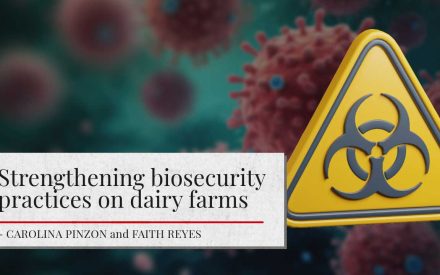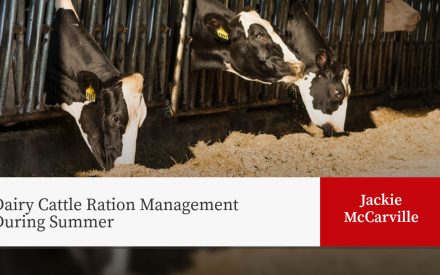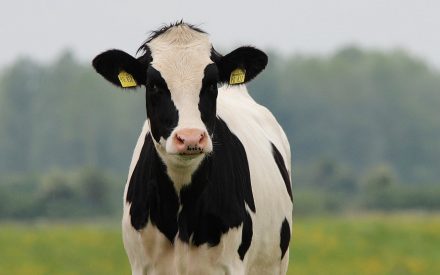
Introduction
Ensuring a comfortable and safe parlor environment for both cows and workers, while efficiently using all available resources—including time—is crucial for the dairy business’ profitability. Milking time on a dairy farm is a balancing act between maintaining cleanliness and calmness while moving quickly enough to finish on time and get the cows back to their pens, where they can eat, drink, rest, and produce milk.
What happens before milking time matters
The release of oxytocin is crucial for milk letdown and for a fast and complete milking. However, once an animal experiences fear or pain, it takes 20-30 minutes to calm down. For this reason, handlers should walk calmly, avoid loud noises, and use gentle pressure to create a smooth flow to the parlor. Traffic areas should be clear of distractions like hanging objects, misplaced hoses, or trash that could slow cow movement.
Crowd gates should be used gently and moved little and often to keep cows near the parlor entrance and minimize empty space in the holding area. Crowd gates should never be used to force cows into the parlor. This misuse raises animal welfare concerns and can impede a smooth flow. Advanced systems using RFID tags can automate this process, reducing stress and improving efficiency.
Cow movers must ensure the parlor never runs out of cows to milk and that the next group is ready in the holding area as the last cow in the prior group finishes milking. Balancing parlor and pen sizes ensures cows spend no more than 60 minutes per milking session away from feed and rest areas.
Consistent milking routine is crucial
Consistency should be maintained in procedures, sequences, and timing. The goal of a milking routine is to attach the milking unit to clean, dry, and well-stimulated teats. It is essential that teat disinfection methods such as dipping, foaming, or spraying ensure adequate coverage and a minimum contact time of 30 seconds for bactericidal effects.
The routine should also involve stimulation for optimal initial and continuous milk letdown, resulting in a faster milk-out process. Stimulation, such as fore stripping, wiping vigorously with a towel, or using an automatic scrubber, should last at least 12-15 seconds to optimize milk letdown. Ideally, the lag time from teat stimulation to milking unit attachment is 60 to 120 seconds. Cows love consistency: therefore, all milking technicians must follow the same steps, in the same order, at the same pace for every cow during each milking session.
Training: A win-win for dairy farmers, workers and cows alike
Training the milking crew on proper cow handling and milking parlor best practices is critical. During team meetings and training sessions, also consider discussing the following key practices that enhance parlor efficiency:
- Prepare all supplies and have them centrally located at the start of milking.
- Nonessential tasks, like refilling dip cups and getting clean towels, should be done at a time that does not interfere with milking.
- Ensure cows enter the parlor voluntarily with minimal human intervention. Do not train cows to get fetched.
- Instruct milkers to stay out of the holding area except at the end of the pen or when handling new animals.
- Avoid loud noises and sudden movements, as these can cause cows to back up and delay milking.
- To move cows forward, use the “walk-back-by” technique, which involves walking in the opposite direction of the cow when loading them onto the platform.
- Begin prepping cows as soon as the first couple of cows are in the milking stalls. Milkers should not wait until the entire side is loaded to start milking.
- Monitor the cows being milked on the other side of the parlor. Re-attach or adjust units as needed so that all cows are finished when it is time to post-dip them.
Conclusion
In conclusion, having a well-trained milking crew that consistently implements best practices in cow handling and milking procedures is essential for optimizing parlor efficiency and enhancing productivity and profitability. Implementing these strategies will streamline the parlor workflow, ensure tasks are completed accurately and promptly, and benefit cows, workers, and owners alike.
Reviewed by
Megan Nelson
Dairy and Livestock Outreach Program Manager
University of Wisconsin – Madison, Division of Extension
Faith Reyes
Dairy Outreach Specialist
University of Wisconsin – Madison, Division of Extension
Author

Carolina Pinzón-Sánchez
Bilingual Dairy Outreach Specialist – As a statewide Dairy Outreach Specialist, Carolina identifies needs and incorporates research findings into high-quality outreach education programs around dairy production.


 Strengthening biosecurity practices on dairy farms
Strengthening biosecurity practices on dairy farms ▶️ Watch: Udderly Efficient: Management strategies for optimal performance
▶️ Watch: Udderly Efficient: Management strategies for optimal performance Dairy Cattle Ration Management During Summer
Dairy Cattle Ration Management During Summer Dry Cow Heat Stress Management
Dry Cow Heat Stress Management


